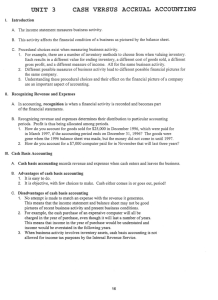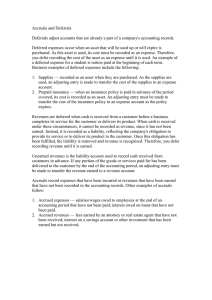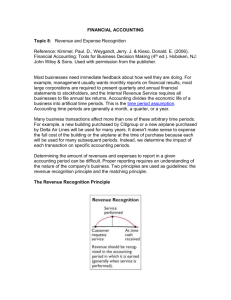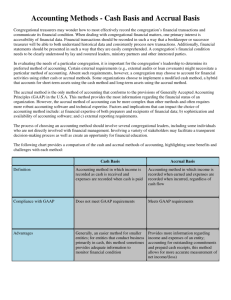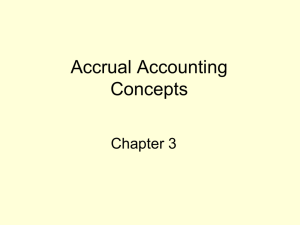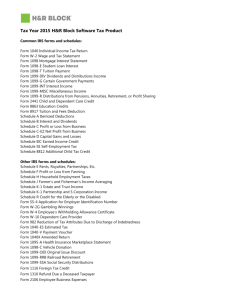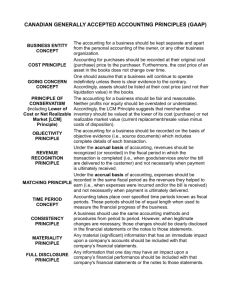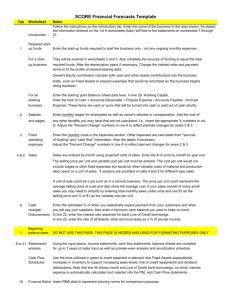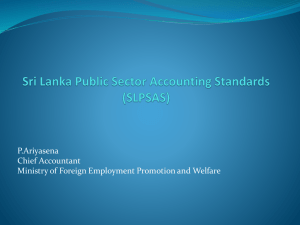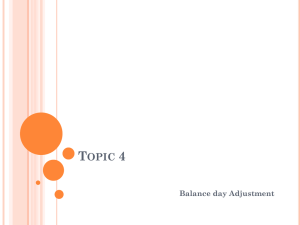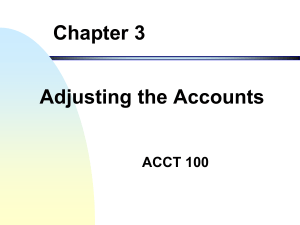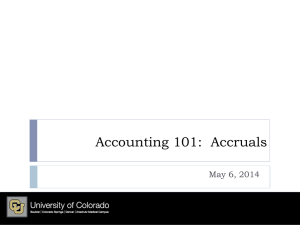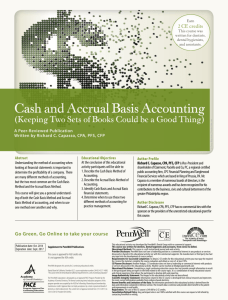UNIT 3 CASH VERSUS ACCRUAL ACCOUNTING
advertisement
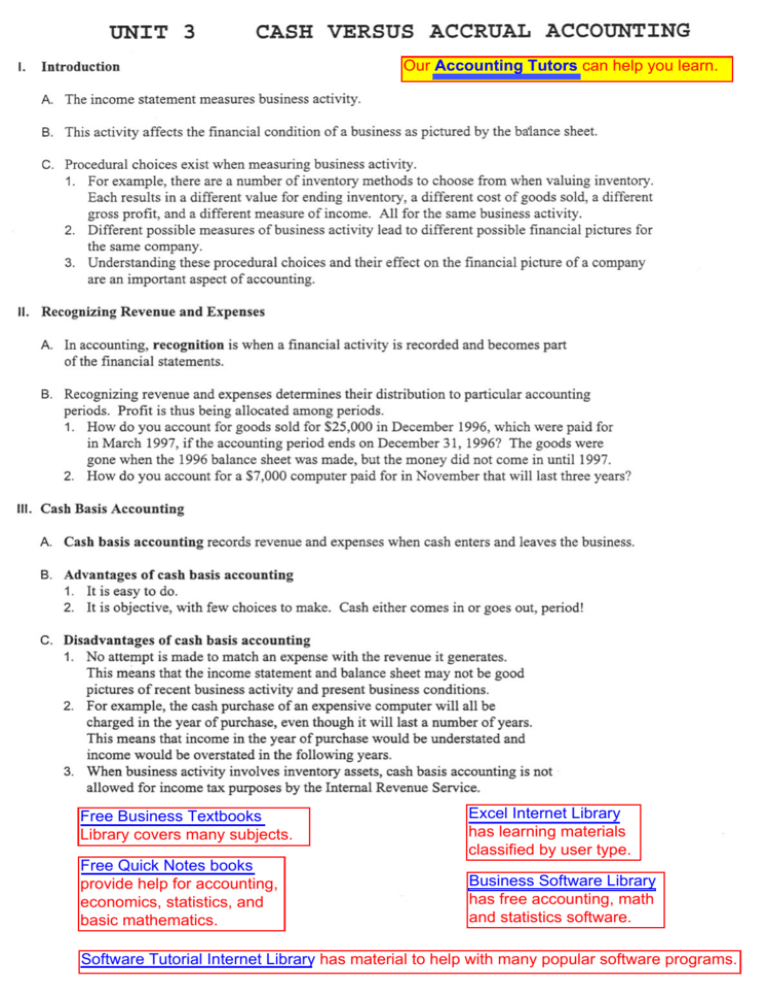
UNIT 3 CASH VERSUS ACCRUAL ACCOUNTING I. Introduction Our Accounting Tutors can help you learn. A. The income statement measures business activity. B. This activity affects the financial condition of a business as pictured by the balance sheet. C. Procedural choices exist when measuring business activity. 1. For example, there are a number of inventory methods to choose from when valuing inventory. Each results in a different value for ending inventory, a different cost of goods sold, a different gross profit, and a different measure of income. All for the same business activity. 2. Different possible measures of business activity lead to different possible financial pictures for the same company. 3. Understanding these procedural choices and their effect on the financial picture of a company are an important aspect of accounting. II. Recognizing Revenue and Expenses A. In accounting, recognition is when a financial activity is recorded and becomes part of the financial statements. B. Recognizing revenue and expenses determines their distribution to particular accounting periods. Profit is thus being allocated among periods. 1. How do you account for goods sold for $25,000 in December 1996, which were paid for in March 1997, if the accounting period ends on December 31, 1996? The goods were gone when the 1996 balance sheet was made, but the money did not come in until 1997. 2. How do you account for a $7,000 computer paid for in November that will last three years? III. Cash Basis Accounting A. Cash basis accounting records revenue and expenses when cash enters and leaves the business. B. Advantages of cash basis accounting 1. It is easy to do. 2. It is objective, with few choices to make. Cash either comes in or goes out, period! C. Disadvantages of cash basis accounting 1. No attempt is made to match an expense with the revenue it generates. This means that the income statement and balance sheet may not be good pictures of recent business activity and present business conditions. 2. For example, the cash purchase of an expensive computer will all be charged in the year of purchase, even though it will last a number of years. This means that income in the year of purchase would be understated and income would be overstated in the following years. 3. When business activity involves inventory assets, cash basis accounting is not. allowed for income tax purposes by the Internal Revenue Service. Free Business Textbooks Library covers many subjects. Excel Internet Library has learning materials classified by user type. Free Quick Notes books provide help for accounting, economics, statistics, and basic mathematics. Business Software Library has free accounting, math and statistics software. 16 to help with many popular software programs. Software Tutorial Internet Library has material IV. Accrual Basis Accounting A. Accrual basis accounting records the financial effects of a business activity in the period the effect occurs. 1. Revenue is recognized (recorded) when earned (the goods were legally transferred or the service performed). a. Cash may come in before revenue is earned, as with a subscription magazine. b. Cash may come in when revenue is earned, as with the sale of a Domino's pizza. c. Cash may come in after revenue is earned, as with the acceptance of a credit card for the sale of a television. d. In all cases revenue is earned when the item changes legal ownership. 2. Expenses are recognized when their benefit is received. a. Cash may go out before the benefit, as with the payment of next year's annual property taxes in September. b. Cash may go out when the benefit is received, as with the payment of a bridge toll. c. Cash may go out after the benefit is received, as with the payment of this period's payroll in the next period. d. In all cases the expense is recorded when the benefit is received. 3. Accrual accounting is based on matching an expense with the revenue it helps generate (matching principle). 4. When an accounting activity spans more than one accounting period, an adjustment is needed at the end of the first period to assure that the revenue is recorded when earned and the expenses are recognized with their benefit. B. Accruals and deferrals 1. Accruals and deferrals are required to conform with the matching principle. 2. Accruals are needed when something has affected the income statement and is unrecorded. a. Accrued revenues have been earned but not recorded. Example: Construction work has been done but not received. It must be recorded with the amount to be received reported as construction revenue on the income statement and accounts receivable on the balance sheet. b. Accrued expenses have been incurred but not recorded. Example: Salaries are earned by employees but not paid. They must be recorded with the a~ount to be paid reported as salaries expense on the income statement and salaries payable on the balance sheet. 3. Deferrals refer to situations where cash is received or paid and the income statement has not been affected. a. Deferred revenue has been received in advance. Example: Revenue from a two-year magazine subscription is received in October and the first magazine won't be sent until next year. This deferred revenue is reported as the liability unearned subscription revenue on the balance sheet. b. Deferred expenses have been paid in advance. Example: Liability insurance for one year is paid in March and coverage begins in April. This deferred expense is reported as the asset prepaid insurance on the balance sheet. C. The advantages and disadvantages of accrual basis accounting 1. Accrual accounting measures current income more accurately than the cash method. a. This means that the balance sheet is a more accurate estimate of financial position (value). b. Accurate, current information makes it easier to predict future income and financial position. 2. Accrual accounting is difficult to understand. a. Confusion exists because net income does not equal the period's change in cash. b. The cash balance of a company with high income may even decrease during the year. c. For example, a rapidly growing, profitable retailer may face a shortage of cash for many reasons. 1) Rapid growth often requires large inventories. New retailers often find that suppliers will not grant credit. This combination increases cash outflows. 2) Gaining market share may require a retailer to grant easy credit terms. This decreases cash inflows. 3) As a result, a very successful business may not have adequate cash. Our 28 Free Internet Libraries have academic and career materials for students, teachers, and professional. 17 MBA Internet Library will help with acceptance, graduation, and career advancement.
